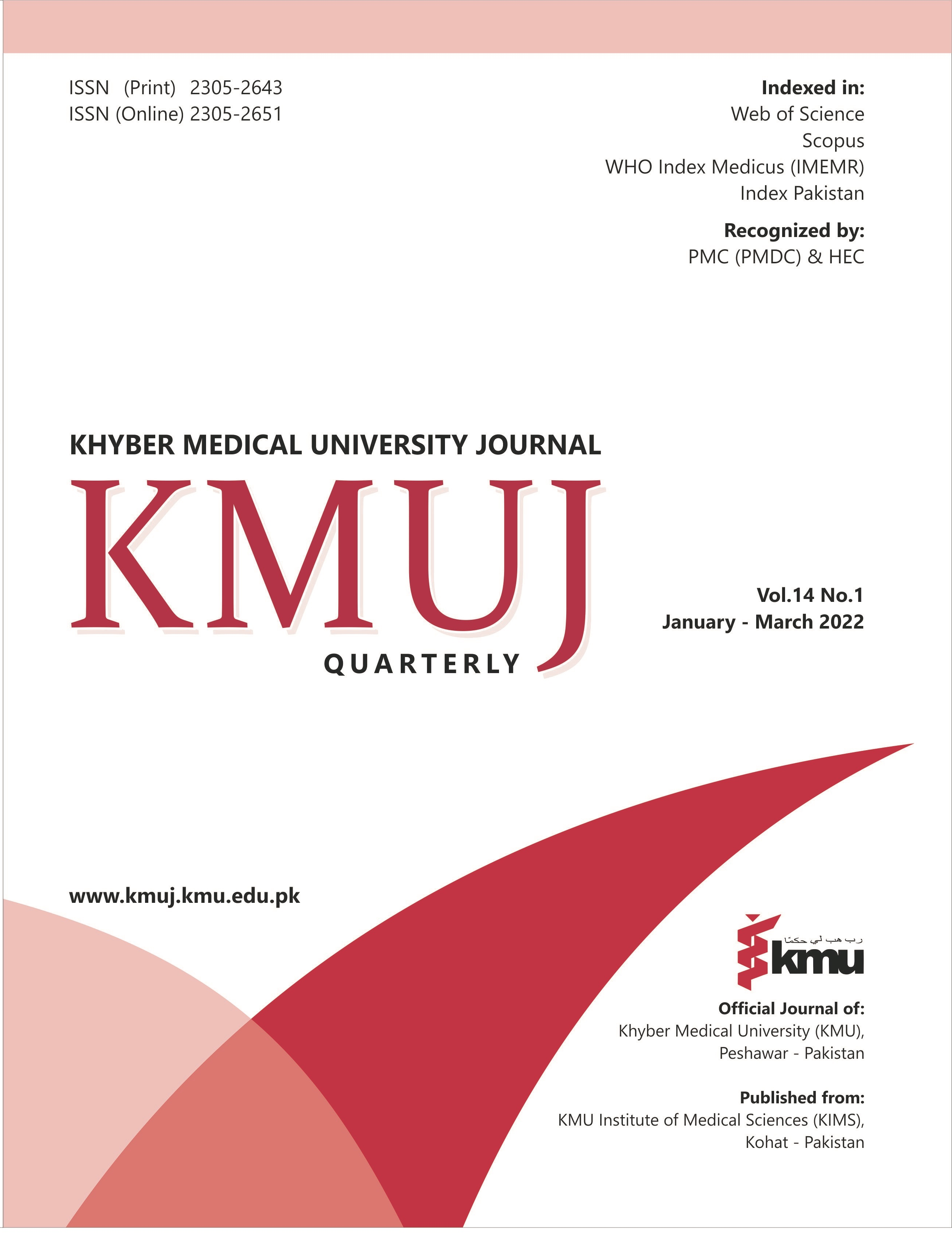COMPARISON BETWEEN ADRENALINE AND WITHOUT ADRENALINE SOLUTION ON BLEEDING CONTROL OF SKIN GRAFT DONOR SITE: A RANDOMIZED CONTROLLED TRIAL
Main Article Content
Abstract
OBJECTIVE: To compare the bleeding control of skin graft donor site between normal saline soaked gauze with adrenaline and conventional technique having no adrenaline.
METHODS: This open-label randomized control trial was conducted at Dr. Ruth K.M. Pfau Civil Hospital, Karachi, Pakistan from October 2020 to March 2021. Seventy-five patients were randomized to interventional (n=36, 48%) and control group (n=39, 52%) through sealed envelopes. Diluted solution was prepared by adding 30cc of Ringer’s lactate and 10cc of lignocaine 2%, with 1cc of adrenaline of 1:200000 with 200 ml of normal saline solution. Solution for control group was containing only normal saline. Following the skin harvesting at donor site, a gauze piece soaked with tumescent solution was applied at the donor site wound. Bleeding severity and epithelialization were assessed. Data was recorded in a pre-designed performa and analyzed through SPSS version-25.
RESULTS: There was no significant differences in baseline characteristics like age (p=0.823), gender (p=0.984) and nature of injury (p=0.936) among two groups. Severe, moderate and mild bleeding was noted in 20/39 (51.3%), 15/39 (38.5%) and 4/39 (10.3%) cases in control group as compared to 0/36 (0%); 2/36 (5.6%) and 25/36 (69.4%) cases in interventional group respectively (**<0.001). No bleeding was noted in 9/36 (25%) cases of interventional group. Complete epithelialization was observed in 24/36 (66.7%) & 17/39 (43.6%) cases in adrenaline and control groups respectively (p=0.045).
CONCLUSION: Application of adrenaline was more effective in bleeding control and early epithelialization at donor site following the skin harvesting as compared to conventional technique.
Article Details
Work published in KMUJ is licensed under a
Creative Commons Attribution 4.0 License
Authors are permitted and encouraged to post their work online (e.g., in institutional repositories or on their website) prior to and during the submission process, as it can lead to productive exchanges, as well as earlier and greater citation of published work.
(e.g., in institutional repositories or on their website) prior to and during the submission process, as it can lead to productive exchanges, as well as earlier and greater citation of published work.
References
Shimizu R, Kishi K. Skin graft. Plast Surg Int 2012;2012:563493. https://doi.org/10.1155/2012/563493
MacFarlane DF. Current techniques in skin grafting. Adv Dermatol 2006;22:125-38. https://doi.org/10.1016/j.yadr.2006.07.002
Prieto ES, López-Herce CJ, Rey GC, Medina VA, Concha TA, Martínez CP. [Prognostic indexes of mortality in pediatric intensive care units]. An Pediatr (Barc) 2007;66(4):345-50. https://doi.org/10.1157/13101237
Yu CC, Gao WJ, Yang JS, Gu H, Md MZ, Sun K, et al. Can tranexamic acid reduce blood loss in cervical laminectomy with lateral mass screw fixation and bone grafting: a retrospective observational study. Medicine (Baltimore) 2017;96(5):e6043. https://doi.org/10.1097/md.0000000000006043
Moran KT, O'Reilly TJ, Furman W, Munster AM. A new algorithm for calculation of blood loss in excisional burn surgery. Am Surg 1988;54(4):207-8.
Fukuoka K, Yagi S, Suyama Y, Kaida W, Morita M, Hisatome I. Effect of Subcutaneous Adrenaline/Saline/Lidocaine Injection on Split-Thickness Skin Graft Donor Site Wound Healing. Yonago Acta Med 2021;64(1):107-12. https://doi.org/10.33160/yam.2021.02.014
Shann F. Are we doing a good job: PRISM, PIM and all that. Intensive Care Med 2002;28(2):105-7. https://doi.org/10.1007/s00134-001-1186-1
Nakamura T, Ariyoshi H, Kambayashi J, Ikeda M, Kawasaki T, Sakon M, et al. Effect of low concentration of epinephrine on human platelet aggregation analyzed by particle counting method and confocal microscopy. J Lab Clin Med 1997;130(3):262-70. https://doi.org/10.1016/s0022-2143(97)90020-2
Lindkvist M, Fernberg U, Ljungberg LU, Fälker K, Fernström M, Hurtig-Wennlöf A, et al. Individual variations in platelet reactivity towards ADP, epinephrine, collagen and nitric oxide, and the association to arterial function in young, healthy adults. Thromb Res 2019;174:5-12. https://doi.org/10.1016/j.thromres.2018.12.008
Rao AK, Willis J, Kowalska MA, Wachtfogel YT, Colman RW. Differential requirements for platelet aggregation and inhibition of adenylate cyclase by epinephrine. Studies of a familial platelet alpha 2-adrenergic receptor defect. Blood 1988;71(2):494-501.
Gacto P, Miralles F, Pereyra JJ, Perez A, Martínez E. Haemostatic effects of adrenaline-lidocaine subcutaneous infiltration at donor sites. Burns 2009;35(3):343-7. https://doi.org/10.1016/j.burns.2008.06.019
Doig GS, Simpson F. Randomization and allocation concealment: a practical guide for researchers. J Crit Care 2005;20(2):187-91. https://doi.org/10.1016/j.jcrc.2005.04.005
Brown RS, Rhodus NL. Epinephrine and local anesthesia revisited. Oral Surg Oral Med Oral Pathol Oral Radiol Endod 2005;100(4):401-8. https://doi.org/10.1016/j.tripleo.2005.05.074
Knoll-Köhler E, Förtsch G. Pulpal anesthesia dependent on epinephrine dose in 2% lidocaine. A randomized controlled double-blind crossover study. Oral Surg Oral Med Oral Pathol 1992;73(5):537-40. https://doi.org/10.1016/0030-4220(92)90091-4
Knoll-Köhler E, Knöller M, Brandt K, Becker J. Cardiohemodynamic and serum catecholamine response to surgical removal of impacted mandibular third molars under local anesthesia: a randomized double-blind parallel group and crossover study. J Oral Maxillofac Surg 1991;49(9):957-62. https://doi.org/10.1016/0278-2391(91)90059-u
Lee RE, Holze EA. The peripheral vascular system in the bulbar conjunctiva of young normotensive adults at rest. J Clin Invest 1950;29(2):146-50. https://doi.org/10.1172/jci102240
Ho CWG, Kok YO, Chong SJ. Photographic evaluation of different adrenaline-containing tumescent solutions on skin graft donor site bleeding: A prospective randomised trial. Burns 2018;44(8):2018-25. https://doi.org/10.1016/j.burns.2018.03.003
Fujita K, Mishima Y, Iwasawa M, Matsuo K. The practical procedure of tumescent technique in burn surgery for excision of burn eschar. J Burn Care Res 2008;29(6):924-6. https://doi.org/10.1097/bcr.0b013e31818b9e7a
Gümüş N. Tumescent infiltration of lidocaine and adrenaline for burn surgery. Ann Burns Fire Disasters 2011;24(3):144-8.
Allorto NL, Bishop DG, Rodseth RN. Vasoconstrictor clysis in burn surgery and its impact on outcomes: systematic review and meta-analysis. Burns 2015;41(6):1140-6. https://doi.org/10.1016/j.burns.2015.03.010
Liu H, Liu Z, Zhang Q, Guo W. Utilization of epinephrine-soaked gauzes to address bleeding from osteotomy sites in non-tourniquet total knee arthroplasty: a retrospective cohort study. BMC Musculoskelet Disord 2020;21(1):578. https://doi.org/10.1186/s12891-020-03595-6
Omura K, Hosokawa Y, Nomura K, Aoki S, Tochigi K, Miyashita K, et al. Effect of gauze placement soaked with adrenaline at suprabullar recess on hemostasis during endoscopic sinus surgery: A randomized controlled trial. Head Neck 2020;42(9):2397-404. https://doi.org/10.1002/hed.26243
Na YC, Park R, Jeong HS, Park JH. Epinephrine Vasoconstriction Effect Time in the Scalp Differs According to Injection Site and Concentration. Dermatol Surg 2016;42(9):1054-60. https://doi.org/10.1097/dss.0000000000000845
Ibrahim A, Ali M, Khafar S. The Effect of Lidocaine with/without Epinephrine on Healing of Cutaneous Incised Wounds in Donkeys: An Experimental Study. J Anesth Clin Res 2015;6(6): 1000533. https://doi.org/10.4172/2155-6148.1000533
